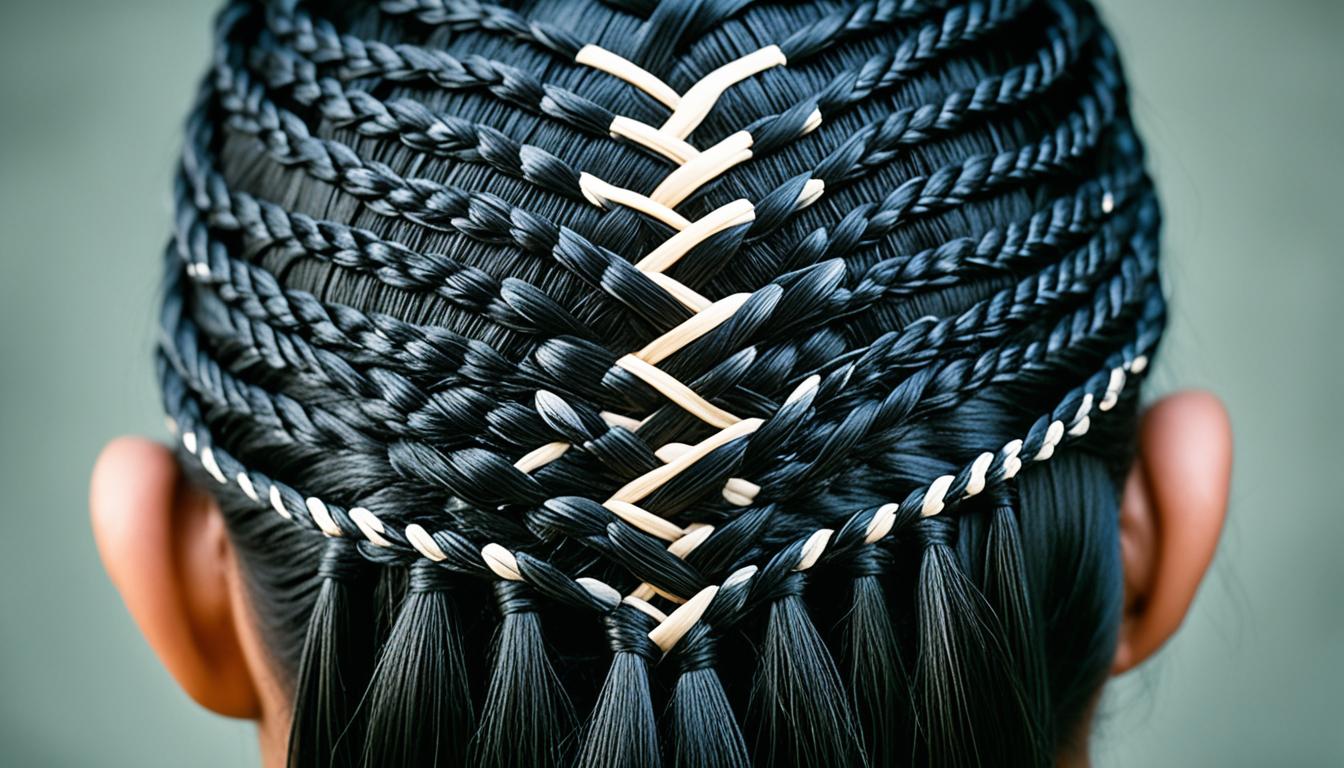
Have you ever wondered why black hair is often braided? What is the cultural significance behind this timeless tradition? And why has braided hair become a symbol of identity and resistance? In this article, we will delve into the history of black hair braiding, explore its cultural significance, discuss different braiding techniques, and look at the popular braided hairstyles for black hair. Get ready to uncover the beauty, symbolism, and power behind the art of braiding!
Key Takeaways:
- Black hair braiding has a rich cultural history and holds deep significance within the black community.
- Braiding techniques served as a form of communication and a way to express social status and cultural identity.
- The practice of braiding hair has evolved over time, with traditional African styles being adapted and modified in different regions.
- Maintaining braided black hair requires proper care and attention to preserve the style and promote hair health.
- The mainstream recognition and influence of braided hairstyles have challenged conventional beauty standards and celebrated black cultural traditions.
The Cultural Significance of Black Hair Braiding
Hair braiding has a rich history deeply rooted in African traditions and customs, dating back centuries. Braiding styles have held cultural significance and served as a means of communication, expressing social status, age, marital status, and tribal affiliation. It was a communal practice, fostering social bonds, and passing down cultural traditions from one generation to the next.
During the transatlantic slave trade, Black people managed to preserve their hair braiding traditions as a form of cultural resistance. Enslaved women particularly used intricate braided patterns to celebrate their heritage and communicate messages, including escape routes for those seeking freedom. The resilience and creativity exhibited through these braiding techniques became a powerful symbol of resistance and identity.
In the post-slavery era, braiding continued to play a vital role in Black communities, serving as a way to reclaim and express cultural heritage while rejecting Eurocentric beauty standards. Braiding allowed individuals to embrace their natural hair textures and celebrate their unique identity, challenging societal norms and embracing their own sense of beauty.
The cultural significance of black hair braiding continues to be cherished and celebrated among diverse Black communities worldwide. It signifies strength, pride, and connection to African roots. Braiding has become a form of self-expression, fostering a sense of belonging and unity.
Evolution of Black Hair Braiding Styles
Black hair braiding has undergone a remarkable transformation over the years, reflecting the dynamic nature of fashion, culture, and societal attitudes. With a rich history rooted in traditional African braiding techniques, the art form has evolved and adapted to different regions and cultures around the world. Today, there is an exciting blend of innovation, creativity, and cultural fusion in the realm of black hair braiding.
Traditional African braiding styles, known for their intricate patterns and deep cultural symbolism, have served as the foundation for contemporary braiding techniques. These styles have been embraced by Black individuals as a means of self-expression, artistic creativity, and celebration of their cultural heritage.
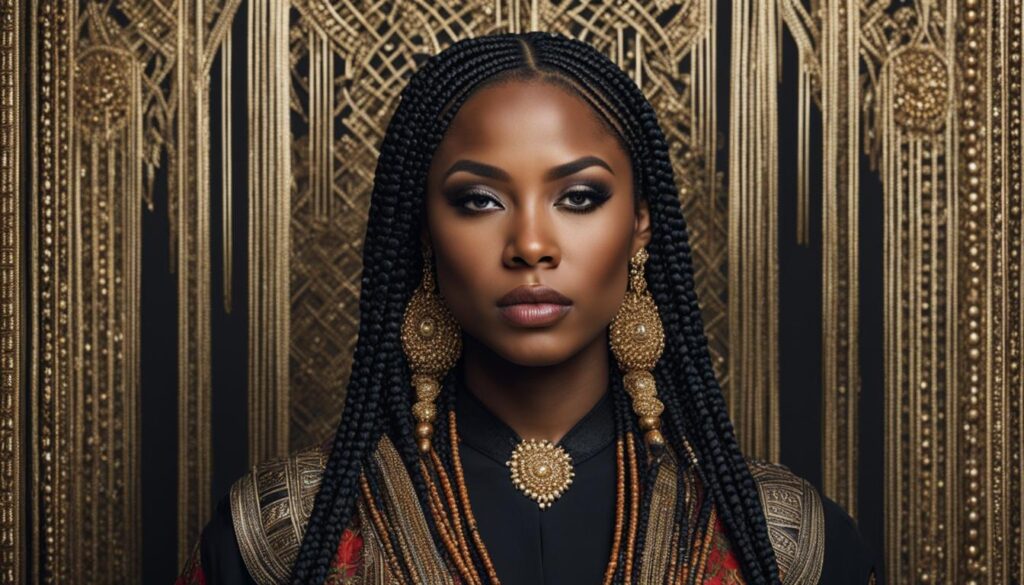
Over the past few decades, there has been a surge in the popularity and diversity of braiding techniques. Hairstylists and braiders have pushed the boundaries of creativity by incorporating elements from various cultures, adding extensions, beads, and accessories to enhance the visual appeal of braided hairstyles.
Ancient Techniques Meet Modern Trends
One of the most significant developments in black hair braiding is the emergence of protective styles. Protective styles, such as box braids, Senegalese twists, Ghana braids, and faux locs, have gained immense popularity due to their versatility and low maintenance.
Box braids, characterized by small, square-shaped sections, are a classic example of a protective style. They are not only visually appealing but also help to protect the hair by reducing manipulation and preventing breakage. Senegalese twists, on the other hand, involve twisting small sections of hair from the roots to the ends. This technique is prized for its natural look and ability to preserve hair length.
Ghana braids, characterized by intricate cornrow patterns, have become a popular choice for individuals seeking a more elaborate and eye-catching style. Faux locs, which imitate the appearance of dreadlocks, offer a temporary alternative to the permanent commitment of traditional locs.
Celebrating Diversity and Cultural Heritage
One of the most remarkable aspects of black hair braiding is its ability to serve as a celebration of cultural heritage. From the intricate patterns of Fulani braids to the bold and vibrant colors of tribal braiding styles, braided hairstyles continue to pay homage to ancestral traditions while embracing modern trends.
With the influence of social media and the widespread dissemination of braiding tutorials, individuals of various cultural backgrounds have embraced black hair braiding as a form of self-expression and solidarity with black culture. This cross-cultural exchange has resulted in the fusion of braiding techniques, creating unique and captivating styles that transcend cultural boundaries.
| Braiding Technique | Description |
|---|---|
| Box Braids | Small, square-shaped sections of hair that are braided from the roots to the ends. They offer versatility and protection for the hair. |
| Senegalese Twists | Twists created by interweaving two strands of hair. These twists are versatile and maintain hair length. |
| Ghana Braids | Intricate cornrow patterns that are braided close to the scalp. Known for their stunning visual impact and cultural significance. |
| Faux Locs | Braids that imitate the appearance of dreadlocks. Offer a temporary alternative to permanent locs. |
Overall, the evolution of black hair braiding styles showcases the resilience and creativity of Black individuals. Through their hairstyles, they continue to reshape beauty standards, express their cultural heritage, and celebrate the diverse and ever-evolving world of black hair braiding.
Maintaining Braided Black Hair
Proper maintenance is crucial for keeping braided black hair healthy and preserving the style. Here are some essential tips for maintaining braided black hair:
- Regular Scalp Cleansing: Cleanse the scalp regularly to prevent product buildup and maintain scalp health. Use a sulfate-free shampoo or a diluted apple cider vinegar rinse to gently cleanse the scalp without stripping it of its natural oils.
- Moisturize Hair and Scalp: Moisturize the hair and scalp to prevent dryness, itching, and breakage. Apply a lightweight leave-in conditioner or hair oil to keep the hair hydrated and nourished. Focus on massaging the moisturizer into the scalp and down the length of the braids.
- Protect Hair at Night: Use a satin bonnet or pillowcase to protect the hair at night. Satin helps to prevent friction and moisture loss, keeping the braids intact and reducing frizz. Alternatively, you can wrap your hair in a satin scarf before going to bed.
- Avoid Excessive Manipulation: Minimize excessive manipulation of the braids to prevent damage. Constant pulling, twisting, or tugging can weaken the hair strands and lead to breakage. Be gentle when styling or touching the braids.
- Schedule Regular Touch-ups: Schedule regular touch-ups and re-braiding sessions to maintain the neatness and longevity of the style. As the hair grows, new growth at the roots may need to be re-braided to maintain a consistent look. Consult with a professional braider to determine the best schedule for touch-ups.
Maintaining braided black hair requires a combination of proper cleansing, moisturizing, and protection techniques. By following these tips, you can keep your braided style looking fresh and vibrant for longer periods.
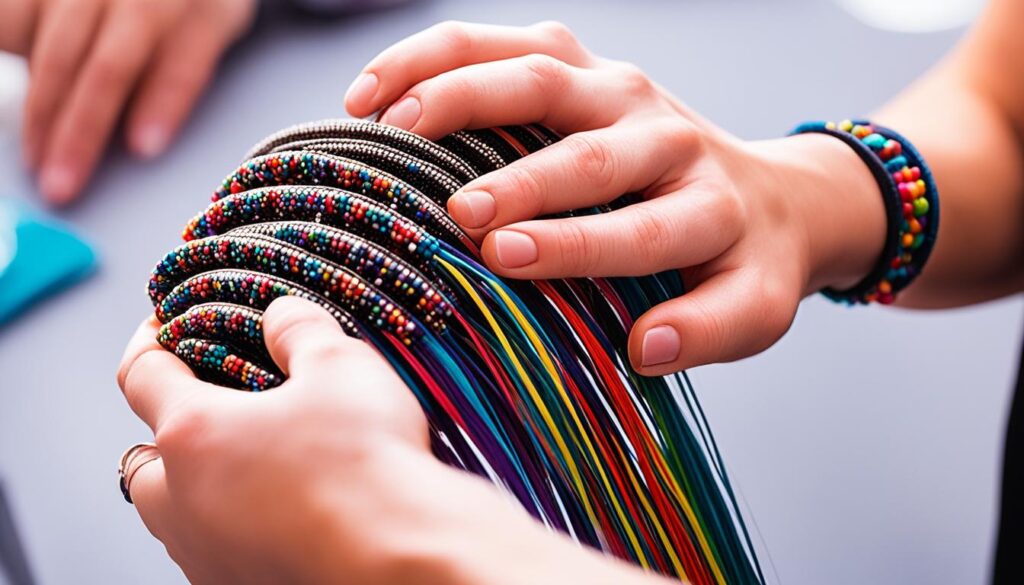
Professional Braiding Industry
The increasing demand for braiding services has fueled the growth of the professional braiding industry. Licensed braiders and specialized braiding salons have emerged, providing their expertise in various braiding techniques for black hair. This professionalization has not only created economic opportunities for Black entrepreneurs but has also established braiding as a recognized and respected profession within the beauty and styling industry.
Professional braiders possess extensive knowledge and skill in different braiding techniques, allowing them to create stunning and intricate styles tailored to individual hair types. They understand the unique needs and characteristics of black hair, ensuring that the braiding process is both safe and beneficial for clients.
In addition to their technical expertise, professional braiders offer valuable guidance and advice to clients seeking the best styles and methods for their hair. They take into consideration factors such as hair texture, length, and desired outcome, ensuring that the chosen braiding technique not only looks beautiful but also promotes hair health and growth.
The Benefits of Professional Braiding:
| Benefits | Description |
|---|---|
| Expertise | Professional braiders are trained and skilled in various braiding techniques, ensuring high-quality and long-lasting results. |
| Customization | Professional braiders can tailor the braiding technique and style to suit individual hair types and preferences. |
| Healthy Hair Care | Professional braiders prioritize the health of your hair, using appropriate products and techniques to minimize damage and promote hair growth. |
| Stress-Free Experience | By entrusting your braiding needs to professionals, you can relax and enjoy a stress-free experience, knowing that your hair is in expert hands. |
Whether you’re looking for a protective style, a trendy braided look, or a special occasion hairstyle, turning to professional braiders ensures that your hair receives the care and attention it deserves. Their expertise and knowledge of braiding techniques for black hair will help you achieve your desired look while keeping your hair healthy and beautiful.
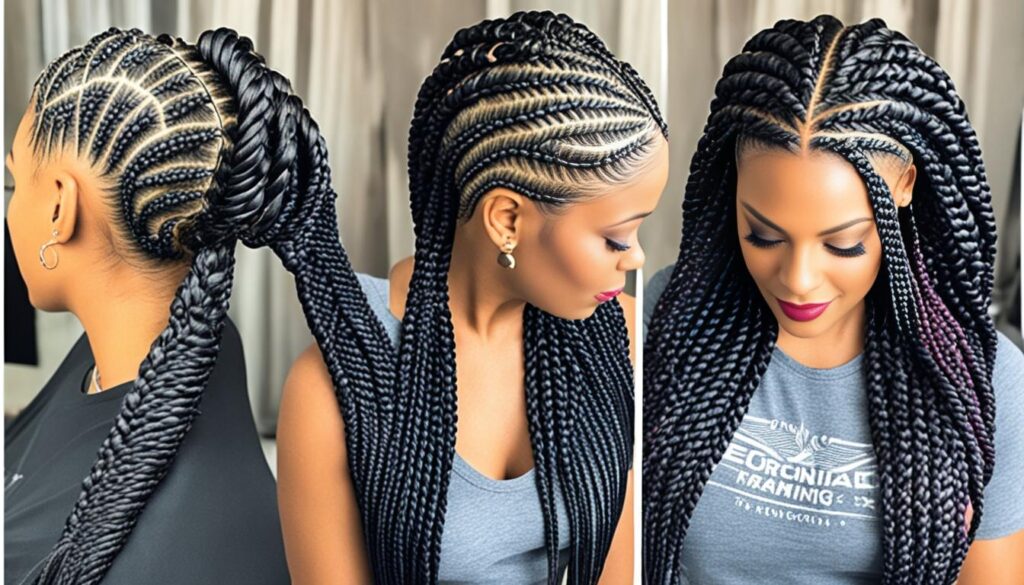
Note: The image above showcases a variety of braiding techniques for black hair.
Mainstream Recognition and Influence
Black hair braiding styles have gained widespread recognition and influence in popular culture. Celebrities, fashion designers, and influencers have embraced braided hairstyles, showcasing them in high-profile events and media. This visibility has contributed to a broader acceptance and appreciation of Black hair braiding and challenged conventional beauty standards.
“Braids have become an empowering symbol of self-expression and cultural pride, breaking down barriers and redefining beauty standards.”
The versatility and beauty of braided hairstyles have made them popular choices for both formal and casual occasions. From red carpet events to everyday street style, braided hairdos have become a fashion statement that transcends cultural boundaries. A-list celebrities like Beyoncé, Rihanna, and Lupita Nyong’o have rocked stunning braided looks that have set trends and inspired countless individuals worldwide.
Braided hairstyles have also become increasingly popular in the music and entertainment industry. Iconic music videos, such as Beyoncé’s “Formation” and Cardi B’s “Bodak Yellow,” feature breathtaking braided hairstyles that have captivated audiences and inspired fans to recreate the looks. In movies like “Black Panther,” braided hairstyles were celebrated as a powerful representation of African culture and identity.
The influence of braided hairstyles extends beyond the realm of entertainment. The corporate world and high-end fashion have also embraced the beauty and elegance of braids. Models don braided hairstyles on prestigious runways, and magazines feature editorials showcasing the latest braiding trends.
One of the significant advantages of braided hairstyles is their low maintenance nature. They provide a long-lasting solution for busy individuals who want to maintain a stylish and put-together look without spending excessive time on daily hair routines. With proper care and maintenance, braided hairstyles can last for several weeks, reducing the need for frequent hairstyling and allowing for easy management of natural hair.
Benefits of Braided Black Hair:
- Protective styling for natural hair: Braided hairstyles help to protect natural hair from damage, breakage, and environmental exposure.
- Low maintenance: Once braided, hair requires minimal styling and upkeep, making it a convenient option for those with busy lifestyles.
- Versatility: Braided hairstyles offer a wide range of styling options, from intricate updos to long flowing braids, allowing for creativity and self-expression.
- Preservation of hair length: Due to reduced manipulation and breakage, braided hairstyles can help retain hair length and promote healthy hair growth.
- Cultural heritage: Braided hairstyles serve as a celebration and preservation of Black cultural heritage, allowing individuals to embrace their roots and express their identity.
The mainstream recognition and influence of braided hairstyles have elevated them from mere trends to timeless and iconic hairstyles. They have become a symbol of beauty, culture, and empowerment, inspiring individuals of all backgrounds to embrace their natural hair and celebrate the diversity of Black hair. Braided hairstyles continue to inspire and evolve, ensuring that they remain an integral part of the fashion and beauty industry.
Social Media and Cultural Influence
The rise of social media platforms like Instagram and YouTube has had a profound impact on the popularity and evolution of braided hairstyles for black hair. These platforms have not only provided spaces for black individuals to showcase their creative braiding styles but have also fostered a sense of community and inspiration among black hair enthusiasts.
On Instagram, black hair influencers share tutorials, tips, and photographs of their stunning braided hairstyles, attracting a wide audience looking to recreate these styles themselves. YouTube, on the other hand, offers more in-depth video tutorials, allowing viewers to learn various braiding techniques for black hair and maintain their braided hairstyles with ease.
Social media has become a powerful tool for popularizing diverse braiding techniques and celebrating the rich traditions of braiding within black culture. It has created a platform for individuals to proudly display their cultural heritage and connect with others who share similar experiences.
Through the use of hashtags such as #braidedhairstyles and #blackhaircare, black hair enthusiasts on social media have created a virtual community that celebrates the beauty and artistry of braided hairstyles. This digital influence has not only contributed to the mainstream recognition of braided hairstyles but has also challenged traditional beauty standards.
Inspired by the braiding traditions in black culture, non-black individuals have also embraced braided hairstyles and incorporated them into their own fashion and self-expression. This cross-cultural influence has further elevated the significance and acceptance of braided hairstyles, forging a greater sense of inclusivity and cultural appreciation.
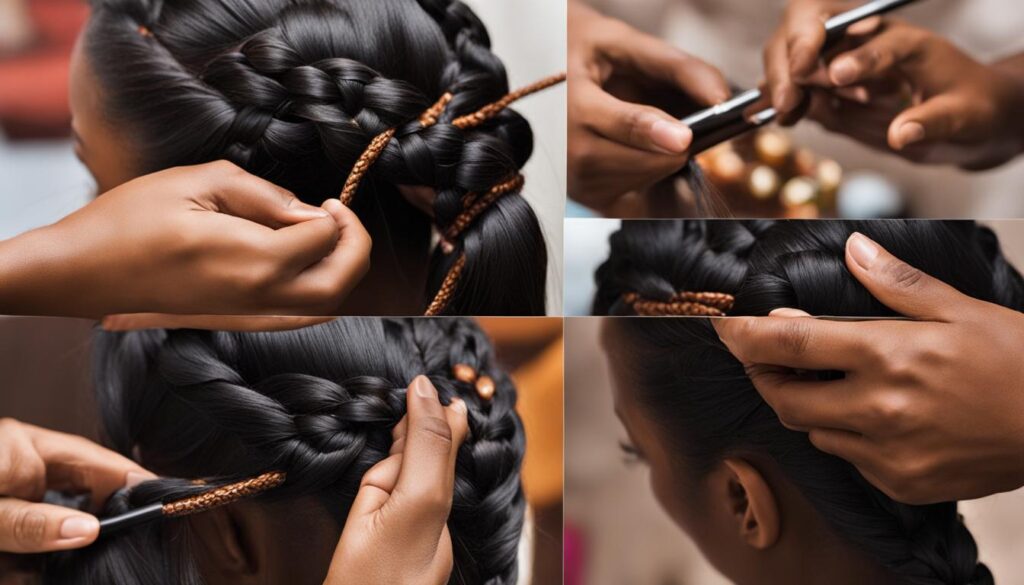
Conclusion
Black hair braiding goes beyond being a mere fashion trend; it holds deep cultural and historical significance. For centuries, braiding has served as a way for Black individuals to reclaim their identity, express their cultural heritage, and resist Eurocentric beauty standards. It has been a powerful form of self-expression, allowing Black people to communicate social status, age, marital status, and even tribal affiliation.
The evolution of braiding styles throughout history reflects changes in fashion and societal attitudes. From traditional African braiding techniques to the innovative styles of today, braids have adapted and evolved while maintaining their cultural significance. Braiding has also become a means of economic empowerment, with the professionalization of the industry creating opportunities for Black entrepreneurs and skilled braiders.
The mainstream recognition and influence of braided hairstyles have challenged conventional beauty standards and contributed to a broader acceptance and appreciation of Black hair. Celebrities, fashion designers, and influencers have embraced braids, showcasing them in high-profile events and media. Moreover, social media has become a platform for Black individuals to share their braiding traditions, inspire others, and celebrate their cultural heritage.
In conclusion, black hair braiding is a powerful form of self-expression, cultural preservation, and resistance. Its significance extends beyond aesthetics, representing social, ethnic, and personal meanings. Through braiding, Black individuals continue to honor their roots, reclaim their identity, and celebrate their beauty.






